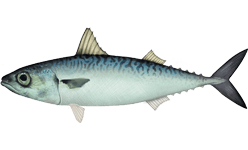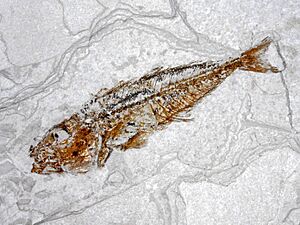Chub mackerel facts for kids
Quick facts for kids Chub mackerel |
|
|---|---|
 |
|
| Conservation status | |
| Scientific classification |
The chub mackerel, also known as the Pacific mackerel or Pacific chub mackerel (Scomber japonicus), is a type of fish. It belongs to the same family as tuna and other mackerels, called Scombridae. This species of mackerel looks very similar to the Atlantic chub mackerel.
Contents
What Makes Chub Mackerel Special?
Chub mackerel have a special air sac called a swim bladder. This bladder is connected to their throat. "True mackerels" from the Scomber group do not have this feature.
How to Tell Them Apart
You can often tell a chub mackerel from an Atlantic chub mackerel by its color. The Atlantic chub mackerel has silvery sides below its middle. The chub mackerel, however, has small dark spots on the lower part of its sides. Chub mackerel also have bigger eyes than Atlantic mackerels.
Fins and Size
Their two dorsal fins (back fins) are closer together on a chub mackerel. The first dorsal fin usually has 9 or 10 spines. Atlantic mackerels typically have 11 or more spines. Most mackerel species travel in large groups called schools. Chub mackerel are smaller than some of their relatives. They usually grow to be about 8 to 14 inches (20 to 36 cm) long.

How Chub Mackerel Live
Chub mackerel swim in large schools, just like Atlantic mackerel. They also eat similar foods.
What They Eat
They often eat the same types of ocean-dwelling crustaceans. These include tiny creatures like copepods and amphipods. They also eat salps, appendicularians, and young herring. Chub mackerel will eagerly follow bait thrown into the water.
Where Do Their Fossils Come From?
Fossils of Scomber japonicus have been found in Italy. These fossils date back to the Pliocene period. This means they lived about 3 to 2.2 million years ago.
Where Do Chub Mackerel Live?
Chub mackerel are found across the Indo-Pacific region. They are not found in most of the Indian Ocean. However, you can find them near South Africa, from KwaZulu-Natal to Western Cape. In the Atlantic, you'll find the closely related Atlantic chub mackerel instead.
Their Ocean Homes
Chub mackerel are common in the northwestern, southeastern, and northeastern Pacific Ocean. In the eastern Pacific, they live from central Mexico up to southeastern Alaska. They usually stay within 20 miles (37 km) of the coast. They prefer waters that are between 50 and 72 °F (10 to 22 °C).
Different Ages, Different Spots
Young mackerel like to live near sandy beaches or in kelp beds. Adult mackerel are found in deeper waters. They can be found on shallow banks down to 1000 feet (300 m) deep. Chub mackerel often school with other ocean fish. This includes other types of mackerels and sardines. In 2015, some chub mackerels found in the Indian Ocean were classified as a new species, Scomber indicus.
What Do Chub Mackerel Eat?
Chub mackerel eat different things as they grow.
Tiny Eaters: Larvae and Juveniles
When they are very young, called larvae, chub mackerel mostly eat copepods and rotifers. Sometimes, they even eat smaller larvae of their own kind. Chub mackerel larvae can eat a lot, up to 87% of their body weight each day. As they get a bit older, becoming juveniles, they mainly eat zooplankton.
Adult Meals
Once they are adults, chub mackerel feed on mysids and euphausids. These are small shrimp-like creatures.
How Chub Mackerel Reproduce
Chub mackerel usually lay their eggs when the water temperature is between 59 and 68 °F (15 to 20 °C). This means their breeding season changes depending on where they live in the world.
Egg Laying
Female mackerel can lay a lot of eggs, typically between 100,000 and 400,000 during the breeding season. They are always competing with other fish for food. While their full growth hasn't been completely studied, we know they can lay eggs from March through October. The busiest time for laying eggs is usually from April through August. Sometimes, females have both fully developed eggs and eggs that are just starting to grow at the same time. This is also seen in Atlantic mackerel.
How Chub Mackerel Stay Safe
Chub mackerel use camouflage to hide from animals that want to eat them.
Hiding from Above
Their back pattern looks very similar to the light and wave patterns on the water's surface. When they are in danger, they swim close to the surface. This helps them blend in with the flickering sunlight. It makes it hard for birds that hunt from above to see them.
Hiding from Below
Their undersides are lighter in color. This is called countershading. It makes it difficult for bigger predatory fish, like tuna and barracuda, to spot them from below.
Chub Mackerel Fishing
Fishermen sometimes call the chub mackerel the hardhead. This fish is often caught and used in different ways.
Uses for Chub Mackerel
It is canned for people to eat, used as pet food, or as bait for other fish. It can also be served fresh. From 1980 to 1989, recreational fishing in California caught an average of 1,462 tons of chub mackerel.
Fishing Trends
The most chub mackerel ever caught was in 1978, with 3,412,602 tons. After that, the catch numbers went down, but they increased a bit in 1995. The best way to catch chub mackerel is using large nets called purse seines. These nets are placed directly around schools of fish. This means that not many other types of fish are caught by accident.
When and Where They Are Caught
Chub mackerel are caught all year round. However, fishing is especially good between June and November. They can be caught on both sides of North America. The most important places for commercial fishing are in California and Mexico.
Chub Mackerel as Food
Nutrition experts say that chub mackerel is a healthy food. It is high in protein and rich in omega-3 and healthy fats.
Good for You!
Because it has a lot of energy and protein, and not many carbohydrates, it is recommended for growing children and pregnant women. However, it might contain some heavy metals, so it's good to be aware of that.
Popular Dishes
Chub mackerel is a popular dish in Sicilian cooking. It is served in many different ways. In Sicily, it has several names, like strummu ucchiutu or occhiutu. When buying the fish, it's best if the meat is firm and the eyes are clear and bright. Most of the time, it's eaten fresh. But it can also be pickled or frozen. In Sicilian food, it's sometimes served raw and filleted. It's marinated in oil, lemon, salt, and pepper. Jorim is a Korean dish made with tofu, vegetables, meat, and seafood. Mackerel is one of the most popular foods for Koreans in jorim.
-
Godeungeo-hoe (raw chub mackerel)
See also
 In Spanish: Estornino para niños
In Spanish: Estornino para niños





